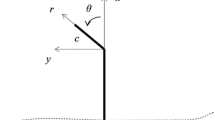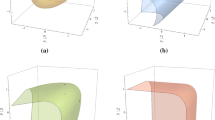Abstract
The tensile strength of brittle and tension-sensitive materials can be determined experimentally by the Brazilian test. To complement the experimental results numerical methods are required which predict the effective properties of the material as an outcome of the calculations. Here a modified phase-field approach to fracture is presented which is able to find the position of the crack, to determine the stress distribution in the (cracking) specimen and to quantify the tensile resistance of the material. Especially we discuss the definition of the phase-field crack driving forces and show by comparison to the analytical solution of the Brazilian test that common strategies of energy splitting are not applicable. Compressive split fracture needs to be driven by the stress state and requires a driving force based on a criterion of fracture mechanics. To demonstrate the predictive capability of the presented approach numerical simulations in two and three dimensions are compared to experimentally obtained results.
























Similar content being viewed by others
References
Abdollahi A, Arias I (2012) Phase-field modeling of crack propagation in piezoelectric and ferroelectric materials with different electromechanical crack conditions. J Mech Phys Solids 60(12):2100–2126
Amiri F, Millán D, Arroyo M, Silani M, Rabczuk T (2016) Fourth order phase-field model for local max-ent approximants applied to crack propagation. Comput Methods Appl Mech Eng 312:254–275
Amor H, Marigo JJ, Maurini C (2009) Regularized formulation of the variational brittle fracture with unilateral contact: numerical experiments. J Mech Phys Solids 57(8):1209–1229
ASTM C. 496/C496M-11 (2011) Standard test method for splitting tensile strength of cylindrical concrete specimens
Awaji H, Sato S (1978) Combined mode fracture toughness measurement by the disk test. J Eng Mater Technol 100(2):175–182
Bilgen C, Weinberg K (2019) On the crack-driving force of phase-field models in linearized and finite elasticity. Comput Methods Appl Mech Eng 353:348–372
Bilgen C, Kopaničáková A, Krause R, Weinberg K (2017) A phase-field approach to conchoidal fracture. Meccanica 53(6):1203–1219
Bilgen C, Kopaničáková A, Krause R, Weinberg K (2019) A detailed investigation of the model influencing parameters of the phase-field fracture approach. Appl Math Mech. https://doi.org/10.1002/gamm.202000005
Boldrini J, de Moraes EB, Chiarelli L, Fumes F, Bittencourt M (2016) A non-isothermal thermodynamically consistent phase field framework for structural damage and fatigue. Comput Methods Appl Mech Eng 312:395–427
Borden M, Verhoosel C, Scott M, Hughes T, Landis C (2012) A phase-field description of dynamic brittle fracture. Comput Methods Appl Mech Eng 217–220:77–95
Borden MJ, Hughes TJR, Landis CM, Verhoosel CV (2014) A higher-order phase-field model for brittle fracture: Formulation and analysis within the isogeometric analysis framework. Comput Methods Appl Mech Eng 273:100–118
Bourdin B, Francfort G, Marigo J (2008) The variational approach to fracture. J Elast 9:5–148. https://doi.org/10.1007/s10659-007-9107-3
BS EN 12390-6 (2009) Din12390-6, testing hardened concrete–part 6: tensile splitting strength of test specimens. Deutsches Institut für Normung, Berlin, pp 336–341
Cai M, Kaiser P (2004) Numerical simulation of the Brazilian test and the tensile strength of anisotropic rocks and rocks with pre-existing cracks. Int J Rock Mech Mining Sci 41:478–483
Dally T, Weinberg K (2017) The phase-field approach as a tool for experimental validations in fracture mechanics. Continuum Mech Thermodyn 29(4):947–956
Föppl L, Föppl A (1920) Drang und Zwang (Eine höhere Festigkeitslehre für Ingenieure), 2Bde. R. Oldenbourg; München und Berlin
Frocht MM (1948) Photoelasticity, vol. ii. N. York p. 333
García VJ, Márquez CO, Zúñiga-Suárez AR, Zuñiga-Torres BC, Villalta-Granda LJ (2017) Brazilian test of concrete specimens subjected to different loading geometries: review and new insights. Int J Concrete Struct Mater 11(2):343–363
Henry H, Levine H (2004) Dynamic instabilities of fracture under biaxial strain using a phase field model. Phys Rev Lett 93:105505
Hertz H (1883) Über die Verteilung der Druckkräfte in einem elastischen Kreiszylinder vol. 28
Khosravani MR, Silani M, Weinberg K (2018) Fracture studies of ultra-high performance concrete using dynamic Brazilian tests. Theor Appl Fract Mech 93:302–310
Klinsmann M, Rosato D, Kamlah M, McMeeking RM (2015) An assessment of the phase field formulation for crack growth. Comput Methods Appl Mech Eng 294:313–330
Kuhn C, Schlüter A, Müller R (2015) On degradation functions in phase field fracture models. Comput Mater Sci 108:374–384
Lancioni G, Royer-Carfagni G (2009) The variational approach to fracture mechanics. A practical application to the french panthéon in paris. J Elast 95(1–2):1–30
Li D, Wong LNY (2013) The Brazilian disc test for rock mechanics applications: review and new insights. Rock Mech Rock Eng 46(2):269–287
Miehe C, Hofacker M, Welschinger F (2010) A phase field model for rate-independent crack propagation: robust algorithmic implementation based on operator splits. Comput Methods Appl Mech Eng 199:2765–2778
Miehe C, Welschinger F, Hofacker M (2010) Thermodynamically consistent phase-field models of fracture: variational principles and multi-field fe implementations. Int J Numer Meth Eng 83:1273–1311
Mußchelischwili NI (1971) Einige Grundaufgaben zur mathematischen Elastizitätstheorie. Fachbuchverlag Leipzig
Patil SP, Heider Y, Padilla CAH, Cruz-Chú ER, Markert B (2016) A comparative molecular dynamics-phase-field modeling approach to brittle fracture. Comput Methods Appl Mech Eng 312:117–129
Ruiz G, Ortiz M, Pandolfi A (2000) Three-dimensional finite-element simulation of the dynamic Brazilian tests on concrete cylinders. Int J Numer Methods Eng 48(7):963–994
Sargado JM, Keilegavlen E, Berre I, Nordbotten JM (2018) High-accuracy phase-field models for brittle fracture based on a new family of degradation functions. J Mech Phys Solids 111:458–489
Thomas M, Bilgen C, Weinberg K (2018) Phase-field fracture at finite strains based on modified invariants: a note on its analysis and simulations. Surveys Appl Math Mech 40(3):207–237
Verhoosel C, de Borst R (2013) A phase-field model for cohesive fracture. Int J Numer Methods Eng 96:43–62
Weinberg K, Hesch C (2014) Thermodynamically consistent algorithms for a finite-deformation phase-field approach to fracture. Int J Numer Methods Eng 99(12):906–924
Weinberg K, Hesch C (2015) A high-order finite-deformation phase-field approach to fracture. Continuum Mech Thermodyn. https://doi.org/10.1007/s00161-015-0440-7
Weinberg K, Khosravani MR (2018) On the tensile resistance of UHPC at impact. Eur Phys J Spec Topics 227(1–2):167–177
Yu RC, Ruiz G, Pandolfi A (2004) Numerical investigation on the dynamic behavior of advanced ceramics. Eng Fract Mech 71(4–6):897–911
Zhu W, Niu L, Li S, Xu Z (2015) Dynamic Brazilian test of rock under intermediate strain rate: pendulum hammer-driven SHBP test and numerical simulation. Rock Mech Rock Eng 48(5):1867–1881
Author information
Authors and Affiliations
Corresponding author
Additional information
Publisher's Note
Springer Nature remains neutral with regard to jurisdictional claims in published maps and institutional affiliations.
Rights and permissions
About this article
Cite this article
Bilgen, C., Homberger, S. & Weinberg, K. Phase-field fracture simulations of the Brazilian splitting test. Int J Fract 220, 85–98 (2019). https://doi.org/10.1007/s10704-019-00401-w
Received:
Accepted:
Published:
Issue Date:
DOI: https://doi.org/10.1007/s10704-019-00401-w




